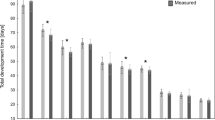Abstract
Homicide investigations often depend on the determination of a minimum post-mortem interval (PMImin) by forensic entomologists. The age of the most developed insect larvae (mostly blow fly larvae) gives reasonably reliable information about the minimum time a person has been dead. Methods such as isomegalen diagrams or ADH calculations can have problems in their reliability, so we established in this study a new growth model to calculate the larval age of Lucilia sericata (MEIGEN, 1826). This is based on the actual non-linear development of the blow fly and is designed to include uncertainties, e.g. for temperature values from the crime scene. We used published data for the development of L. sericata to estimate non-linear functions describing the temperature dependent behavior of each developmental state. For the new model it is most important to determine the progress within one developmental state as correctly as possible since this affects the accuracy of the PMI estimation by up to 75%. We found that PMI calculations based on one mean temperature value differ by up to 65% from PMIs based on an 12-hourly time temperature profile. Differences of 2°C in the estimation of the crime scene temperature result in a deviation in PMI calculation of 15–30%.





Similar content being viewed by others
References
Adams Z, Hall M (2003) Methods used for the killing and preservation of blowfly larvae, and their effect on post-mortem larval length. Forensic Sci Int 138(1–3):50–61
Amendt J, Zehner R, Reckel F (2008) The nocturnal oviposition behaviour of blowflies (Diptera: Calliphoridae) in Central Europe and its forensic implications. Forensic Sci Int 175(1):61–64
Anderson G (2001) Forensic entomology: the utility of arthropods in legal investigations. In: Chapter. Insect succession on carrion and its relationship to determining time of death. CRC, Boca Raton, pp 143–175
Archer M, Elger M (2003) Female breeding-site preferences and larval feeding strategies of carrion-breeding Calliphoridae and Sarcophagidae (Diptera): a quantitative analysis. Aust J Zoology 51:165–174
Archer MS (2004) The effect of time after body discovery on the accuracy of retrospective weather station ambient temperature corrections in forensic entomology. J Forensic Sci 49(3):553–559
Arnott S, Turner B (2008) Post-feeding larval behaviour in the blowfly, Calliphora vicina: effects on post-mortem interval estimates. Forensic Sci Int 177(2–3):162–167
Benecke M (1998) Six forensic entomology cases: description and commentary. J Forensic Sci 43(4):797–805; 1303
Goff M (1993) Estimation of postmortem interval using arthropod development and successional patterns. Forensic Sci Rev 5(2):81–94
Grassberger M, Frank C (2004) Initial study of arthropod succession on pig carrion in a central European urban habitat. J Med Entomol 41(3):511–523
Grassberger M, Reiter C (2001) Effect of temperature on Lucilia sericata (Diptera: Calliphoridae) development with special reference to the isomegalen- and isomorphen-diagram. Forensic Sci Int 120(1–2):32–36
Greenberg B (1991) Flies as forensic indicators. J Med Entomol 28(5):565–577
Higley L, Haskell N (2009) Forensic entomology, the utility of arthropods in legal investigations, 2nd edn. Chapter. Insect development and forensic entomology. CRC LLC, Boca Raton, pp 389–405
Lane RP (1975) An investigation into blowfly (Diptera: Calliphoridae) succession on corpses. J Nat Hist 9:581–588
Lowne B (1890) The anatomy, physiology, morphology and development of the blow-fly. RH Porter, London
Mansson RA, Frey JG, Essex JW, Welsh AH (2005) Prediction of properties from simulations: a re-examination with modern statistical methods. J Chem Inf Model 45(6):1791–1803
Reibe S, Madea B (2010) How promptly do blow flies colonise fresh carcasses? A study comparing indoor vs. outdoor locations. Forensic Sci Int 195:52–57
Slone D, Gruner S (2007) Thermoregulation in larval aggregations of carrion-feeding blow flies (Diptera: Calliphoridae). J Med Entomol 44(3):516–523
Smith KE, Wall R (1997) The use of carrion as breeding sites by the blowfly Lucilia sericata and other Calliphoridae. Med Vet Entomol 11(1):38–44
Tao S (1927) A comparative study of the early larval stages of some common flies. Am J Epidemiol 7:735–761
Author information
Authors and Affiliations
Corresponding author
Rights and permissions
About this article
Cite this article
Reibe, S., Doetinchem, P.v. & Madea, B. A new simulation-based model for calculating post-mortem intervals using developmental data for Lucilia sericata (Dipt.: Calliphoridae). Parasitol Res 107, 9–16 (2010). https://doi.org/10.1007/s00436-010-1879-x
Received:
Accepted:
Published:
Issue Date:
DOI: https://doi.org/10.1007/s00436-010-1879-x




